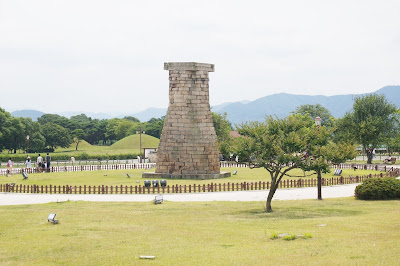Gyeongju
was the capital city of the ancient kingdom of Silla (BC57~AD935). The city is
often referred to as a “museum without walls” because of the many cultural
relics scattered throughout the city. Many of the hills are actually royal
tombs and fields of grass used to be sites of ancient temples. Many sites have
been designated as World Heritage Sites by UNESCO.
* Bus
KTX Station - Bus terminal - Gyeongju Railroad Station - Donggung - Bulguksa Temple: No. 700
Bus Terminal - Donggung -Bulguksa Temple: No.10
A. Daereungwon
Tumuli Park and Cheonmachong Tomb
Daereungwon
Tumuli Park Belt are tombs and burial places of high personages including
kings, queens, and nobility.
They were excavated and at Cheonmachong Tomb out of them, rare and precious artifacts including gold crown and Cheonmado
(heavenly horse painting) were discovered.
Cheomseongdae is the oldest existing astronomical observatory in
Asia. It was constructed during
the reign of Queen Seondeok (632-647). This stone structure is a beautiful
combination of straight lines and curves.
C. Wolseong
Palace Site (Banwolseong Fortress)
This was the location of the palace fortress during the Silla
Dynasty. (57 BC ~ AD 935). The fortress takes after its name, which, literally
translated, means 'a crescent moon shape on top of a hill'. Although the
magnificent grandeur of the palace is now just an empty lot, it has been told
that this area was filled with imperial buildings during the dynasty.
D. Donggung Palace and Wolji Pond
Donggung Palace and Wolji Pond were the secondary palace site
which was used for the palace of the Crown Prince along with other subsidiary
buildings and it also was the banquet room for important national event and
important visitors.
E. Bulguksa Temple
Bulguksa Temple, the representative relic of Gyeongju was built
in 528. It is home to many important cultural relics such as Dabotap Pagoda,
Seokgatap Pagoda, Yeonhwa-gyo & Chilbo-gyo Bridges, Cheongun-gyo &
Baegun-gyo Bridges, the Golden Seated Vairocana Buddhist Figure, the Golden
Seated Amita Figure, and Saritap Pagoda.
F. Seokguram Grotto
Seokguram Grotto, the greatest masterpiece of the golden age of
Silla, was completed in 774 A.D. It is a heritage property in which
architecture, mathematical principles, geometry, religion, and art are
collectively realized through its design and construction.










